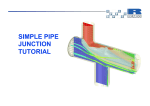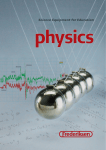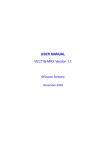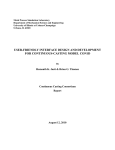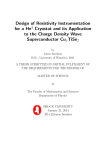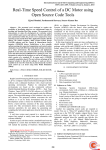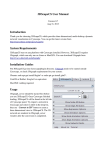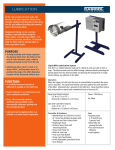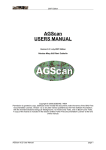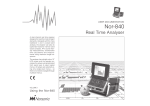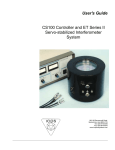Download VECTIS 2012.1 Release Notes
Transcript
Ricardo Software VECTIS 2012.1 Release Notes Release Contents This note announces the release of the 2012.1 version of VECTIS. This is the first release to unify all VECTIS software components and supersedes the previous releases of both VECTIS 3.13 and VECTIS-MAX 1.2. VECTIS is a 3D CFD tool specifically developed for automotive and IC engine applications. Users are advised to refer to the VECTIS and VECTIS-MAX product manuals for usage instructions. This version of VECTIS is available for lnx_x23, lnx_x23.64, win32 and win64 platforms (see specifics below). VECTIS GUI programmes may be started from the Programs menu on Windows platforms and all programs may be started by typing the program name, e.g.: phase5 -V 2012.1 at a command prompt on any platform. The release notes have been separated into the following sections: VECTIS Solver (phase5) VECTIS GUIs (phase1, phase5gui, phase6) Meshing Tools (phase2, phase4, vmesh) VECTIS-MAX Solver and GUI (vsolve and R-Desk plugin) Please also review the R-Desk release notes for additional changes related to post-processing VECTIS using the R-Desk Viewer plugin. Supported Platforms The supported platforms for both 32-bit & 64-bit hardware: RedHat Linux 4, 5 & 6; SUSE Linux 9 & 10 Windows XP/Vista/7 Windows HPC Server 2008 R2 The following MPI options are supported for parallel simulations: INTEL-MPI 4.02 (MPI) on Linux & Windows HP-MPI 2.2 (MPI) on Linux & HP-MPI 1.1 (MPI) on Windows 1 of 17 VECTIS 2012.1 Release Notes 21 September 2012 Ricardo Software Supported compilers for compiling user functions are: Intel Fortran Compiler 12.1.1 (12.1-2076) on Linux and Windows gfortran – the GNU Fortran compiler 4.4, 4.5 & 4.6 on Linux and Windows On Linux, users must ensure that the library libglut.so.3 is installed. This library is required for the meshing products VMESH and PHASE4. This library can be easily downloaded for any Linux distribution. 2 of 17 VECTIS 2012.1 Release Notes 21 September 2012 Ricardo Software VECTIS Solver (phase5) Major Enhancements Enhanced Combustion Progress Variable Library (CPV Library) VEC5-1591 CPV models have been enhanced to include Model 3 and Model 6 to enhance the table and list the change rate of the combustion progress variable with time. The CPV Model 3 and Model 6 can calculate both enthalpy from temperature, and temperature from enthalpy. More information and general setup can be found in the user manual. Wall temperature modifier for moving meshes and crosslinks VEC5-1143 It is now possible to use the wall temperature modifier option for moving mesh calculations. The mapping is now performed after every cross-link and can also be re-mapped after every iteration if required, allowing boundary conditions to be applied to moving and interpolating boundaries. More information and general setup can be found in the user manual. Correction for high evaporation rates in multi-component fuel evaporation model VEC5-1478 It is assumed in the existing multi-component fuel evaporation model that the droplet evaporation rates are relatively low and thus, the mixing of the liquid inside the droplet is fast enough so that no concentration gradients occur in the liquid. This assumption is sometimes referred to as rapid-mixing model. The correction to the existing model has been implemented, which adjusts the instantaneous molecular weight of the evaporating fuel based on the Peclet number. The Peclet number is defined as the proportion between the rates of droplet evaporation and that of diffusion within the droplet interior. The influence of the finite liquid diffusion in the droplet interior is thus taken into account. Multi-fuel capability for spray model VEC5-1492 The existing VECTIS solver can simulate flows with only one fuel. In the case of two-phase flow simulations, the fuel can occur in both the liquid and gaseous phase. The new multi-fuel capability allows for the simulations of several fuels each of which may occur in both the liquid and gaseous phase. This makes it possible to run simulations for the following cases: Two or more injectors, each injecting a different liquid fuel An injection of a liquid fuel while a different gaseous fuel is simultaneously inducted into the computational domain Accordingly, instead of specifying a single fuel for all the injectors in the spray model set-up, it is now possible to define a different fuel for each of the injectors separately. The corresponding properties for each of the fuels are also defined in the gas flow species set-up using an extension to the existing set of VECTIS species. Corresponding initial and boundary conditions are also set for each of the gaseous fuels. 3 of 17 VECTIS 2012.1 Release Notes 21 September 2012 Ricardo Software User-defined coefficients in the droplet impingement model VEC5-1540 An extended input of the droplet impingement model has been implemented for the wall film or moving wall film models to provide users with the possibility of adjusting the majority of the impingement model parameters and thus, to obtain a better agreement with experimental data. The additional input values allow for adjusting the transition criteria between the normal and Leidenfrost impingement regimes as well as between the stick, rebound, spread, splash, and adhesion/stick impingement modes. In addition, users are allowed to adjust the proportion between the mass of secondary droplets and that of impinging drops for the splash impingement mode. Super-heated break-up model with an enhanced break-up time scale estimation VEC5-1592 In order to address the following issues of the existing super-heated break-up model (model I): 1. Time step dependency of results 2. Cooperation of the super-heated break-up model with classical (aerodynamic) break-up models two break-up models (models II and III) suitable for break-up predictions under super-heated conditions have been implemented: In order to avoid the time step dependency of results, model II uses the Kitamura's correlation for a cavitation droplet growth rate to estimate the time necessary for the droplets to break up due to the internal superheat. The stepwise break-up sequence is used in the model, where the droplets reduce to their stable sizes once the break-up time elapses. Model III was implemented to overcome both above-mentioned drawbacks. This model includes both the super-heated break-up predictions-based on the same theory as model II and the aerodynamic break-up predictions based on the well-known Reitz-Diwakar model theory. The outcomes of both the super-heated and aerodynamic break-up are predicted in parallel and the break-up with shorter time scale is chosen as the decisive type of break-up. The corresponding stable droplet size and the break-up time scale are then used for the predictions of the droplet break-up consequences. User-specified coefficients for wall-film heat and momentum transfer VEC5-1488 The predictions of the mass, momentum and heat transfer processes between the wall film and surrounding gas and those between the wall film and the wall can now be influenced by specifying coefficients in the spray input file. More information and general setup can be found in the user manual. 4 of 17 VECTIS 2012.1 Release Notes 21 September 2012 Ricardo Software Gravity effects in wall-film model VEC5-1494 The wall film model newly allows for: Specification of wall-film acceleration due to gravity force component parallel to the wall surface The effects of gravity when the gravity force component is acting towards the wall can also be specified. In this case the wall-film thickness should gradually level off (the liquid should flow from the patches with bigger film thickness to those with smaller film thickness). Please note that existing wall-film solver does not include the full two-phase flow solution with free surfaces and thus, many flow features that may play an important role under some conditions are neglected, such as the surface tension. Also note that this feature has no effect if the gravity force points in the direction away from the wall. In this case, the liquid should gradually accumulate on patches with higher thickness until the liquid drips down. This, however, cannot not be simulated using the available models. Minor Enhancements Define impingement types for each specific boundary VEC5-1498 A new input option has been implemented that allows the user to specify different impingement models for different boundaries. For example, in a port-injected engine simulation, the port would use "Wall film" while the piston and liner could be defined as "Stuck". In previous versions the chosen spray impingement model was always applied globally to all boundaries. User defined maximum wall-film thickness VEC5-1499 The maximum wall film thickness can now be adjusted by the user through the spray input file. If the input is not used in the spray input file the default value of 1.4 [mm] is used to be consistent with previous versions of VECTIS. Liquid jet approximation model VEC5-1638 Gas solver instability (negative gas temperatures or densities) has been encountered for gasoline direct injection simulations with early fuel injection using cluster-hole nozzles. This introduces many droplet parcels (several closely-spaced nozzle orifices) with significant momentum in one or a few computational cells in the gas flow solution with negligible gas masses (low-density gas due to low cylinder pressure). The fuel evaporation is often rapid due to the low ambient pressure. The liquid jet approximation model has been implemented to address the above issues. The transfer processes (mass, momentum, heat) between the injected droplets and surrounding gas are corrected to follow a predicted finite rate of the initial liquid jet break-up into individual droplets. This decelerates significantly the inter-phase transfer processes in the vicinity of the injection point and helps to stabilise the gas flow solution in the affected area. In addition, this approach is compatible with frequently used method of prescription the primary breakup outcomes in terms of tabled data on initial droplet sizes or using the initial droplet size distribution. 5 of 17 VECTIS 2012.1 Release Notes 21 September 2012 Ricardo Software User-defined parameters for bag break-up in the Reitz-Diwakar break-up model VEC5-1560 The stripping-type break-up parameters, Cs1 and Cs2 (see the spray theory manual), in the Reitz-Diwakar break-up model can already be adjusted by users. They correspond to WSCRIT and CBU2 values in phase5gui, respectively. The bag break-up parameters can now be defined by users. The required constants Cb1 and Cb2 (see the Reitz-Diwakar model section in the spray theory manual), are named in correspondence with the notation of existing break-up model parameters as: WBCRIT is the drop size parameter for bag break-up regime of Reitz-Diwakar model (Cb1) with the default value equal to 6 CBU1 is the break-up time parameter for bag break-up regime of Reitz-Diwakar model (Cb2) with the default value equal to π More information and general setup can be found in the user manual. Enhancements of Droplet Impingement Model VEC5-1635 Several enhancements to existing wall-film and moving wall-film impingement models have been implemented to improve the user's control over the simulations: Estimation of Splashing Drop Properties – If a user-defined transition criterion K is used, the evaluation of the properties of splashing droplets can be influenced by an additional option. This option indicates if the user-defined transition criterion K is to be used or if the splashing droplet properties should be evaluated using the droplet Weber number. See documentation for more information. Splashing-to-Impinging Mass Portion – The evaluation of the portion of splashing mass according to Kuhnke's correlation can now be activated. Splashing Threshold Calculation – An additional option can be used for definition of the critical values of the user-defined transition criterion. Wall-film output file (*.WF) writing options VEC5-1640 If the wall film model is activated, the *.WF files were printed out by default for all wall boundaries. This required extra space for storage of the files even if the boundary-specific wall-film data was not of interested for given application. An optional argument has been implemented and can be used in the existing input for boundary impingement types in *.SPR file, which indicates whether or not the corresponding *.WF file should be printed. Improvements to writing timed post-processing and restart files in multi-cycle simulations VEC5-1644 The user now has the option of specifying more than one cycle number when a timed post-processing or restart file should be written. In the case of timed restarts, the user can additionally indicate if a restart file is to be overwritten in later cycles or preserved. 6 of 17 VECTIS 2012.1 Release Notes 21 September 2012 Ricardo Software User defined post-processing interval VEC5-1610 The user now has the ability of changing the frequency of the post-processing writes so that they get more information in key regions and less information in others. Extend LAMINAR FLAME SPEED MODEL to use user-defined models VEC5-1561 A user function option for specifying laminar flame speed has been added. It can be invoked by specifying a new block in the input file. More information and general setup can be found in the user manual. Create rs-mpi for versions LAM 7.1.2 and LAM 7.1.4 RSMPI-19 A problem was detected with the VECTIS solver (phase5) as it is linked with LAM711. It has been addressed by dynamically linking with Intel libraries instead of statically linking. Disable diagnostic message generated by RV5\_Porous\_Cell user function VEC5-1655 Diagnostic messages generated by the RV5_Porous_Cell user function must now be activated by setting the environment variable RV5_USER_DEBUG to 2 or greater. Implement OR and AND operations for user functions VEC5-1687 Two new functions have been added to the user functions access library: Global_SUML_AND – reduces the logical variable passed to it over all parallel domains with the AND condition (i.e. the result returned is True if the variable is True for all processes and False otherwise). In C binding, the integer type is used instead of the logical type. Global_SUML_OR – reduces the logical variable passed to it over all parallel domains with the OR condition (i.e. the result returned is True if the variable is True for at least one process and False otherwise). In C binding, the integer type is used instead of the logical type. Allow user functions to be built using the "umake" script VEC5-1685 Allow user functions written in FORTRAN and C/C++ to be built using the "umake" utility. On Windows, automatically build serial and parallel versions of the user function. Corrections Combustion model terminates for G-eq/Multi-Cycle run VEC5-1519 It was reported that multi-cycle simulations with G-equation combustion model stopped in the second cycle if the ignition started at a position near the end of the first cycle. This has been addressed. Auto-ignition observed in intake/exhaust port VEC5-1595 Auto-ignition was observed in intake or exhaust ports due to changes related to CPV models 3-6. This has been addressed. 7 of 17 VECTIS 2012.1 Release Notes 21 September 2012 Ricardo Software No combustion (no burning) observed for CPV Model3 when combined with G-equation VEC5-1598 An error in the calculation of the progress variable has been addressed. Value of G is reset for multi-cycle calculations VEC5-1600 The value of G is reset to -10 if current local time is greater than or equal to ignition time. This works well for single cycle calculations and for multi-cycle calculations the value of G was reset between ignition time and TDC. Hence, for multi-cycle calculations the code was modified to use current global time instead of current local time. ZONAL_INITIAL_CONDITION location check timing does not always work VEC5-1602 The identification of zones using the reference point specified in the .INP file was done at the beginning of computation. This behaviour was modified to identify at the time specified via ZONAL_INITIAL_CONDITION in SCR VEC5-1515 but this behaviour appears to have been inconsistent as reported by some users. This has now been addressed. Serial and Parallel MIF runs with CPV-6 produce different soot mass fractions VEC5-1620 Errors found in parallel calculations have been addressed. There is now a single functionality used for both serial and parallel calculations unlike two different ones used earlier. Some loop-dependent variables were used outside the loop and hence were not defined at the beginning of the loop. This has also been addressed. Read temperature from SFE files in either Celsius or Kelvin units VEC5-1623 A new option has been introduced in order to read temperature data from .SFE files with correct units. It relies on a function which makes a simple assumption that if any temperature data is less than 100 then the unit is Celsius, otherwise the temperature is assumed to be in Kelvin. Problems with writing post-processing and restart files VEC5-1637 Previously the solver might incorrectly skip writing of regular post-processing, timed post-processing and timed restart file as well as duplicate regular post-processing writes. These issues have been addressed. Incorrect reporting negative temperatures in gas solver VEC5-1643 Under some conditions, the solver stopped due to negative temperatures found in gas flow solution without a proper warning message. Additionally, the solver could crash due to incorrect cross-domain calls during the printing of the messages. A warning message is now printed on the screen and also to corresponding output files together with the properties of affected cells. 8 of 17 VECTIS 2012.1 Release Notes 21 September 2012 Ricardo Software Incorrect splashing droplet parameters in wall-film droplet impingement model VEC5-1646 The fixes and enhancements have been done in order to address the following two issues in the wall-film droplet impingement model: There was no limit for the minimum size of droplets created after droplet splashing. This could result in the creation of droplet parcels with sizes close to or below the minimum permitted droplet diameter in the spray model (0.1 micron). The whole droplet parcel was then immediately transferred to gas. As the number of droplets in the created parcel could be significant, the total parcel mass was often large in comparison with that of gas in the surrounding cell. This often caused instabilities in the gas flow solution where the solver was terminated due to negative temperatures or densities. An additional parameter can be specified in the spray input file to influence the minimum size of droplets after their splashing/rebound on solid surfaces to avoid the above-mentioned issues. The direction of droplets created as a consequence of the droplet impingement in the vertical breakup mode of the Leidenfrost impingement regime was not predicted accurately due to underestimation of the droplet deflection angle from the solid wall surface. This resulted in subsequent movement of splashing droplets along (or through) solid walls. The droplets were often identified as lost during later spray solver integration. This led to the immediate transfer of affected droplet parcels into gas, which could also lead to instabilities of the gas flow solution. A more accurate correlation for predicting the flight direction of splashing droplet is used to avoid the above-mentioned problems. Simulation stops without warning during cross-link VEC5-1589 A problem was found on Windows 64-bit operating systems during cross-links. This has been addressed. Change of title "Unrecognised Inputs" to "Advanced Options" in GUI VEC5G-484 The title of the menu item “Unrecognised Input" and panel “Unrecognised Input Panel" has been changed to “Advanced Options" and “Advanced Options Panel" respectively to reflect new options added in the 2012.1 release. 9 of 17 VECTIS 2012.1 Release Notes 21 September 2012 Ricardo Software VECTIS GUIs (phase1, phase5gui, phase6) Corrections Phase1 crashes on RedHat VEC1G-754 It was reported that phase1 crashed on systems running RedHat version 5.3 and above. This has been addressed. Crash when launching Eccentric Conrod panel on lnx_x23.64 VEC1G-755 On 64-bit Linux, the Eccentric Conrod panel could not be launched, crashing the program. This has been addressed. Merge tolerance units get mixed up when appending files VEC1G-756 There was a problem with units of vertex merge tolerance if another geometry was appended to the existing geometry. The entered merge tolerance was incorrectly multiplied with an incorrect multiplier and thus the vertices of the geometry were merged incorrectly. This has been addressed. 11 of 17 VECTIS 2012.1 Release Notes 21 September 2012 Ricardo Software Meshing Tools (phase2, phase4, vmesh) Major Enhancements Generation of VECTIS3 meshes using VECTIS-MAX mesher (vmesh) VPROJ-10 (V4M-66,V4M-85) VECTIS3 meshes can be now generated by using vmesh module (when the -V3 command line option is used). The name of the link file as output inherits the base name of the input mesh file (e.g. pipej.DAT). Surface re-meshing V4M-96, 103, 116, 129, 135 It is now possible to re-triangulate surfaces using VMESH. This capability has been developed to address the need for new polyhedral meshes. As this tool is still under development, there are certain limitations: Uniform size of generated triangles should be required only. Although it is possible to set different refinements for boundaries, tying of triangles between spots with different density of triangles is not yet sufficiently resolved. The tool is not as robust as desired; at times some additional manual reparation is necessary (usually just a very small part of the surface is missing, which can be easily repaired in phase1). Polyhedral meshes V4M-115 VMESH can now create polyhedral meshes. Please see the VECTIS-MAX User Manual for details on how to use this feature and the meshing algorithm. Minor Enhancements Implement geometry motion to allow meshing of moving cases V4M-85 The movement of boundaries has been implemented in the same style as done in phase2. There is a new command line option, -time. When this switch is used, boundaries with specified motion are shifted to the position corresponding to the given time before the meshing starts. Improved automatic reparation of surface V4M-112 The automatic reparation of the input surface has been greatly improved. There are several more types of defects that can be automatically repaired by VMESH. Previously-used command line options -rep and -sep have been replaced by commands -surfrepair and -surfanalyze. Please see the VECTIS-MAX User Manual for more details. 13 of 17 VECTIS 2012.1 Release Notes 21 September 2012 Ricardo Software Corrections Phase4 crashes after reading *.DAT file VEC4-185 Phase4 could crash after reading the .DAT file, caused by memory allocation of patch points. This has been addressed. Phase4 stops as there is no west neighbour of a global cell VEC4-187 Phase4 could stop with a message that no west neighbour of a glocal cell could be found. This has been addressed. Too high blending when different requirements met V4M-130 There was an issue in VMESH that lead to an incorrect (unnecessarily high) blending in some cases. In the case when different boundary refinement settings met in one global box, the maximum refinement depths and one of the blending distances were used. This has been addressed. Bug fixes in Cartesian meshing V4M-131, 133, 134 There were changes in routines responsible for generation of patches by Marching Cubes method, routine generating internal faces and also in -conform tool. Cartesian meshing is more robust now. Known Issues Both VMESH and PHASE4 will fail on Linux operating systems if the library libglut.so.3 is not installed on the system. This library can be easily obtained for any Linux distribution. 14 of 17 VECTIS 2012.1 Release Notes 21 September 2012 Ricardo Software VECTIS-MAX Solver and GUI Major Enhancements Full Arbitrary Grid Interface (Full AGI) for conformal joining of grid interfaces and its integration into vpre VPROJ-26 In the previous 1.2 release, the node-less (weak-AGI) method for joining non-conformal grids along common geometrical interfaces was introduced for conjugate heat transfer analysis and sliding grids. This method provides only the areas of the newly generated faces, without the corresponding grid topology (vertices, edges, etc.). Consequently, the face centres and normals were estimated based on the geometry of the two input faces. The new, Full AGI calculates the complete grid topology along the common interface, ensuring accurate predictions of face centres and face normals. The full AGI is recommended for conjugate heat transfer analysis and creation of sub-domain interfaces in the case of porous media modelling. The weak AGI must be still used for unsteady sliding grid simulations of rotating components. Provision of wall boundary thermal conditions using SFE files VMAXS-289 For each wall boundary, the spatial distribution of either temperature or heat flux can be now obtained from Ricardo's Standard Finite Element (SFE) file. As this distribution is defined in terms of the Finite Element (FE) grid, its mapping from the FE grid to the VECTIS-MAX solver grid is required. Mapping is done with the help of FEARCE/SFE routines, which provide geometric interpolation factors and the interpolated values. Due to limitations of these routines the solver might generate warnings regarding the success of the mapping process. These warnings indicate that the thermal mapping process will not always provide the smooth spatial distribution. To improve the mapping, the VECTIS-MAX solver first limits the interpolated values on the given boundary by original node values form the FE model and then limits all boundary values by the global minimum/maximum values from the whole SFE model. Variable solid material properties VMAXS-290 Solid material properties such as thermal conductivity, specific heat and density can be defined as a function of temperature, in a similar way as fluid properties. For each property, the following functional dependencies on the temperature are available: Exponential function Expression function Piecewise linear function Piecewise polynomial function User-defined 15 of 17 VECTIS 2012.1 Release Notes 21 September 2012 Ricardo Software Improvement of the Realisable k-epsilon model in terms of the dissipation rate equation VMAXS-358 Validation studies exposed some shortcomings of the Realisable k-&epsilon model (used with or without a low-Reynolds number variant) with respect to the size of recirculation regions. The correct size of the recirculation region, for example for the turbulent flow past a backward-facing step, can be obtained after sensitising the model coefficient for production of the dissipation rate of turbulent energy to the strain tensor invariant. Minor Enhancements Revisiting criteria for poor quality cell definition VMAXS-258 The average wall distance criterion for poor quality cells was modified. Contribution of a neighbouring cell to the average wall distance is now weighted by the area of the shared internal face. This modification produces a more realistic number of poor quality cells for grids composed of prisms with the high aspect ratio. Import of CFS BOXER grids VPROJ-36 BOXER is a mesh generation software tool developed by Cambridge Flow Solutions Ltd. BOXER has been designed to create body-conformal, unstructured grids for geometries of arbitrary complexity in an automated way. Currently BOXER produces hybrid grids (tetrahedra, prisms, pyramids and hexahedra) of guaranteed quality with viscous layers where input geometry comes from STL and other CAD formats. Static pressure value at the reference location in incompressible flow VMAXS-356 Static pressure has not been set to zero at the reference point for incompressible cases where there are no pressure boundaries in the problem. As it is more convenient to work with the zero pressure value at the reference point this value is now set to zero. Documentation The VECTIS-MAX User Manual has been significantly updated. Acknowledgements: This section now lists all third party software used in VECTIS-MAX. Variable solid material properties: A new section, 'Setting a solid phase and its properties', is available in the MODELLING CONTINUA chapter, placed after the 'Setting a fluid phase and its properties' section. Provision of wall boundary thermal conditions using SFE files: The chapter 'BOUNDARY & INTERFACE CONDITION TYPES' has been modified to include setting up of wall thermal conditions using SFE files. Both R-Therm and SFE conditions form now a new section 'Interfaces to Ricardo's Wall Thermal Conditions', for which an appropriate Introduction is provided. A new sub-section related to the usage and setting of SFE files is available. Full Arbitrary Grid Interface: Section 'Mesh Joining' in the 'Reading and Manipulating Meshes' chapter has been extended to cover the usage of full AGI. 16 of 17 VECTIS 2012.1 Release Notes 21 September 2012 Ricardo Software Solver running: Introductory section in the 'USING SOLVER' chapter contains now more details about running the solver in parallel mode using both HP and INTEL MPI. Also, the command line arguments for the effective usage of a new Run Distribution license Manager (RDM) are explained. Polyhedral meshing: Chapter 'MESHING' contains a new section devoted to the new 'Polyhedral Meshing' feature. Corrections Post files writing fails for sliding sub-domain interface VMAXS-353 This has been addressed. Gas constant for the multi-component phase was not calculated correctly VMAXS-335 Calculation of the gas constant for the mixture of species in the corresponding routine was wrong. Note however that the gas constant for the mixture of species has not been used for any other subsequent calculations. Input field for the mass diffusion in Fluid Species panel disabled VMAXGUI-213 The user could not specify the correct value for the species molecular mass diffusion and the default value of 1 was written to the input file. This problem has been now rectified by enabling the mass diffusion input field. Parent phase ID for species is wrong in the input file VMAXGUI-214 In R-Desk versions 1.3 to 1.6 the parent ID for fluid species could be set to zero, causing the solver to crash. The parent ID for fluid species now always refer to the corresponding phase. The species ID in the GUI is always set to 1 VMAXGUI-215 The species ID in the GUI was always set to 1 but should increment for each species added to the problem. This has been addressed. 17 of 17 VECTIS 2012.1 Release Notes 21 September 2012

















